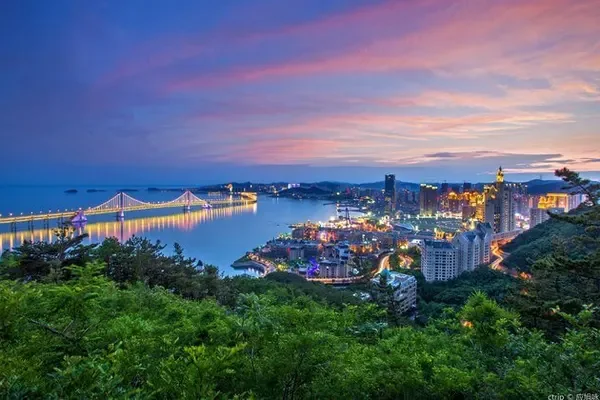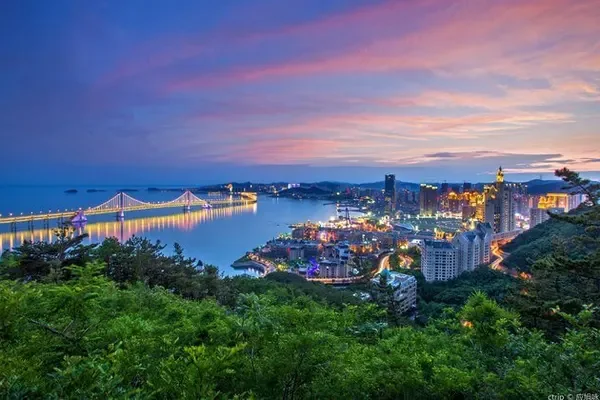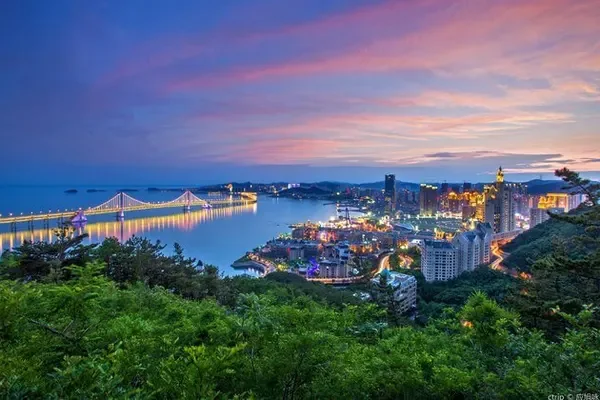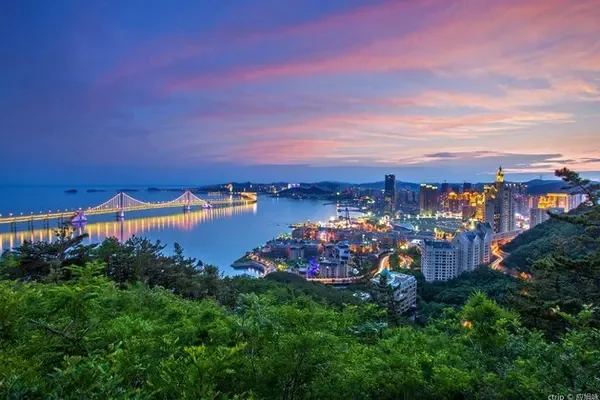Hassan's "The Most Beautiful Under Heaven" and "The Most Beautiful Grassland Under Heaven" sung by Suolang Tashi later sang the scenery of Keshigten Banner in Inner Mongolia all over. I went to Ulan Butong when I went to Bashang a few years ago, and I didn’t have enough time to visit other scenic spots in Keshigten Banner. Last year, Keshigten Stone Forest Scenic Spot was upgraded to a national 5A-level scenic spot, so I have to go even more. A few days before the Mid-Autumn Festival, my daughter and son-in-law suddenly said that they would take a day off and take the baby to Taiyuan, Shanxi and Pingyao for four days during the Mid-Autumn Festival, so we had more than four days to travel. I originally thought about going to Jiangxi, but after reading the weather forecast that there would be rain in Jiangxi, I made some careful calculations and decided to go to Keshiketeng, and visit the Lugou Bridge and Wanping Ancient City, which I have never been to, and visit my uncle Tang in Beijing.
The specific itinerary is: fly from Guangzhou to Beijing Nanyuan Airport on the first night, fly to Chifeng from Nanyuan Airport on the second morning, rent a car in Chifeng and drive to Keshiketeng Daqingshan Scenic Area, and then go to Shuhui Town to stay in hot springs. On the third day, drive through Huanggangliang Linhai to visit Keshiketeng Stone Forest Scenic Area, and then drive through Gongger Grassland to Dali Lake for accommodation. On the fourth day, visit Dali Lake in the morning, lunch at Jingpeng Town, where Keshigten Banner is located, and then drive back to Chifeng. Accommodation near the Marco Polo Bridge. On the fifth day, I visited the Marco Polo Bridge in the morning. I planned to visit my uncle in the afternoon but failed, so I took a taxi to the Capital Airport for accommodation. On the sixth day, fly back to Guangzhou early in the morning.
Since it is just our husband and wife traveling, the expenses are relatively casual, and car rental and accommodation are more expensive during the Mid-Autumn Festival, so the expenses are not referenced for latecomers, so they are not listed here.
D1, Guangzhou----Beijing
After my daughter bought a flight ticket for September 11th at 20:30, we bought a flight ticket from Guangzhou to Beijing Nanyuan Airport at 21:35, and booked a Nanyuan Hotel on Ctrip that can pick up and drop off the airport. In the afternoon, I took my grandson home from the kindergarten in advance, and after serving his dinner, I took the subway to the airport with him. On the way, I meet my daughter who is off work, and then meet my son-in-law who is off work at the north of the airport. After that, the family of three boarded the plane at Terminal T1, and we returned to Terminal T2. Arrived at Nanyuan Airport at about 12:30, took the hotel's pick-up car to the hotel, and took a break after one o'clock.
D2, Beijing Nanyuan----Chifeng----Keshigten Daqingshan----Reshui Town
Get up at 4:30 in the morning, pack up and take the hotel shuttle bus that departs at 5:00 to return to Nanyuan Airport. Take the United Airlines flight to Chifeng at 6:30. After picking up the car at the airport, drive directly to Heshigten Banner. According to the actual time, we decided to go to Daqingshan Scenic Area first.

Nearly twelve o'clock, I arrived at a farm not far from the Daqingshan Scenic Area - "Wudong Post Station", where I went to the scenic spot after having lunch.

Keshiketeng Banner Daqingshan is the most distinctive tourist attraction in Inner Mongolia and one of the nine parks of the Keshiketeng Banner Global Geopark. The scenic spot has the first mountain cableway in Inner Mongolia, known as "the most pictographic stone in Inner Mongolia". The main landscapes of the scenic spot include the remains of the fourth season of Inner Mongolia glaciers, rock mortars, pictographic stones, peak forests, and alpine meadows. Just like in the lyrics of "The Most Beautiful Grassland in the World", "The most beautiful scenery in the world is standing on the top of Daqing Mountain". Looking inside is a large alpine meadow with strange rocks everywhere. Looking down the mountain, there are endless peaks and green peaks. The most amazing thing is that there is a stone mortar under a boulder. Where did the boulder come from? How is the mortar under the boulder generated? There is no scientific explanation, so it is called "the mystery of the world".















After coming out of the Daqingshan Scenic Area, I decided to go to Rehuitang Hot Spring to see if the time allowed. Immediately went to Ctrip to book a room with a hot spring pool in the "Hexigten Banner Tianmu Hot Spring Reception Center". After driving for more than an hour, we arrived at Tianmu Hot Spring Town in Kexiketeng Grassland in Rehuitang Town. This hot spring town is quite beautifully built. It is separated from the main area of Rehuitang Town by a small river, but apart from Tianmu Hot Spring The other houses are empty and not rented out. What I need to complain about is that this hotel is very inhumane for the guests staying in it. It takes more than 200 meters to walk from the parking lot to the hotel lobby, and there are more than a dozen steps. The "soup house" we live in is even more depressing. After completing the procedures in the lobby, you have to carry your luggage up the stairs to the second floor, pass through the restaurant on the second floor, and then go down one and a half stairs. I don't know how it was designed?
For dinner, I walked a few hundred meters to a restaurant in Rehuitang Town for dinner. I ordered a wild mushroom stewed chicken and two Dali Lake Huazi fish. Huazi fish is said to be unique to Dali Lake (Dali Lake is a closed inland saltwater lake. Since the supply is less than the evaporation, the lake water is becoming more and more alkaline, so many fish in the lake have disappeared. Only two kinds of fish can Survived, one of them is Huazi.), because it is caught in winter, so you can’t eat live fish, they are all frozen, and the fish are not big, and they are all fried. In the evening, I soaked in the hot spring in the pool in the room.



D3, Reshuitang----Huanggangliang----Hashatu Stone Forest----Gonger Grassland----Northern shore of Dali Lake
After breakfast at the hotel, I went to visit the hot spring area (it’s not open yet). There are still many hot spring pools, both open-air and indoor. There is also a swimming pool, which should be pretty good in the north. Due to time constraints, we had to leave for the next destination.


Not long after we started on the road, we passed the "Very Black Village", which has become an Internet celebrity because of its special name. There seemed to be a lot of farmhouses in the village, so we didn't have time to stay, but just took pictures at the entrance of the village.


Going forward, the car climbs up a mountain, and the view from the top of the mountain is "the vast Huanggang Liang Linhai" in the song. Pass through the Huanggangliang Forest Farm and continue to the north. When it is close to eleven o’clock, you will arrive at the national 5A-level scenic spot-Kashketeng World Geopark Hashatu Stone Forest Park (also known as Keshiketeng Stone Array). Even though the sky didn't seem so friendly, we decided to go in. There are No. 1, 2, 3, and 4 scenic spots in the park, and there are scenic spots connected by traffic vehicles. We visited three scenic spots 1, 2, and 3, and bought a bowl of noodles for lunch in the scenic spot. The weather began to clear up, and we finished our tour at 2:30 in the afternoon. Ashatu Stone Forest is a Quaternary glacial relic, carved by wind and sand for millions of years, and inlaid on the vast prairie. Stones of different shapes can be imagined at will.










Set the GPS to the North Shore Scenic Spot of Dali Lake, and along the Dada Line known as the "Prairie Sky Road", enjoy the "most beautiful in the world" Gongger Grassland along the way. Although "the most beautiful in the world" is a bit exaggerated, the Gongger Grassland is indeed beautiful. Herds of cattle and sheep and the endless grassland make people feel refreshed. Arrive at the gate of the scenic spot on the north shore of Dali Lake at about five o'clock. Next to the gate is the hotel. After staying in the hotel, you can overlook the Dali Lake from the window of the room. Dinner was settled at the hotel, and I still ordered two Huaziyu, which was exactly the same as the day before.







D4, North Shore of Dali Lake----Jingpeng Town (where Ke Banner is located)----Chifeng City----Beijing
Buy a ticket in the morning and drive into the scenic spot, transfer to the sightseeing bus at the sightseeing station to the lake. I walked around the lake and found nothing bright, then took a sightseeing bus to the bird watching promenade, but unfortunately there are no impressive birds this season. Passing through the bird watching corridor is a large wetland covered with reeds, which is very spectacular. We walked along the boardwalk in the wetland and took pictures, and finally walked back to the place where we parked.
Drive to visit the Hexigten World Geopark Museum not far away, and then drive to Jingpeng Town for lunch. I still ordered two Huaziyu. After a few days, the meal in Jingpeng Town was the best and the most cost-effective. The "milk chewing mouth" made with milk and fried millet is delicious, and the Huazi fish is also better than the previous two.
After lunch, we drove back to Chifeng Airport. It was still early when we arrived in Chifeng City, so we drove around the city of Chifeng and watched the city. Then refuel, return the car, and fly to Beijing Nanyuan Airport by plane at 6:30 in the evening. After arriving at Beijing Nanyuan Airport, I waited for a taxi for more than half an hour. I got in the car and heard from the driver that it was a rehearsal for the National Day military parade. Many roads were closed, so many taxis simply took a break, making it difficult to get a taxi. Take the taxi directly to the Hanting Hotel near Lugou Bridge.





D5, Marco Polo Bridge----Beijing International Airport----Guangzhou
In the morning, take a taxi to the east gate of Wanping Ancient City. Wanping City is located in the east of Lugou Bridge. It was built in the reign of Chongzhen in the late Ming Dynasty (1638) to prevent the peasant army from attacking the capital. It took three years to build. In the Ming and Qing Dynasties, it was called Gongbei City and Gongji City. On July 7, 1937, the Japanese invading army conducted a provocative exercise near Lugou Bridge, and then provoked an incident to bombard Wanping City. This was the famous "July 7 Incident" in history, and China's full-scale Anti-Japanese War broke out.
I used to think that the Marco Polo Bridge was in the north of Beijing. It was not until I did my homework that I realized that it was in the southwest corner of Beijing. My doubts came again. Before the "July 7th Incident", the Japanese army only occupied the three eastern provinces, and North China still belonged to China. Jiao and the Japanese army (I believe many people will have the same doubts)? After searching online for a while, it turns out that this is a good thing done by Lafayette Cixi! When the Eight-Power Allied Forces captured Beijing, the Empress Dowager Cixi fled westward with Emperor Guangxu in her arms. Finally, the most humiliating "Xin Chou Treaty" in modern Chinese history was signed with the great powers. In addition to huge indemnities, the "Xin Chou Treaty" actually allows foreign troops to be stationed in Beijing and 12 strategic locations along the line from Beijing to Shanhaiguan. This humiliating treaty brought the ambitious Japanese army into the core area of North China. Japan thus established the "Chinese Garrison Army (also known as the North China Garrison Army)" and continued to secretly increase its troops until the "July 7th Incident". The "Chinese Garrison" has increased to more than 20,000 people. It was the 3rd Battalion of the 1st Battalion of the Infantry Brigade of the Chinese Garrison stationed in the Fengtai area of Beiping that caused the "Marco Polo Bridge Incident".
After entering Wanping City, walk west along the main street, and there is the "Chinese People's Anti-Japanese War Memorial Hall" in the center of the city. After visiting the "Memorial Hall", continue westward, and the west gate of the city is the famous Lugou Bridge. There are not many historical sites in Wanping City, but Lugou Bridge has retained most of its original features, and some of the lions on the bridge deck and guardrail are historical sites. The lions on the guardrail are different, and there are one or several small lions of different sizes and shapes under many big lions, so there is an allegory of "the lions of Lugou Bridge---innumerable."
Come out from the west end of Lugou Bridge and walk more than one kilometer back to our hotel. Originally, the time in the afternoon was reserved to visit my uncle in Beijing, but due to various reasons, I didn’t make it. So after checking out at noon, I went to the "Qingfeng Baozi" shop next to the hotel to have lunch, and then took a taxi to the hotel near the Capital International Airport to stay and rest.










D6, Beijing Capital International Airport----Guangzhou
I came out at five o'clock in the morning and took the hotel's locomotive to the airport, and took the early flight back to Guangzhou at six thirty to end the trip.



